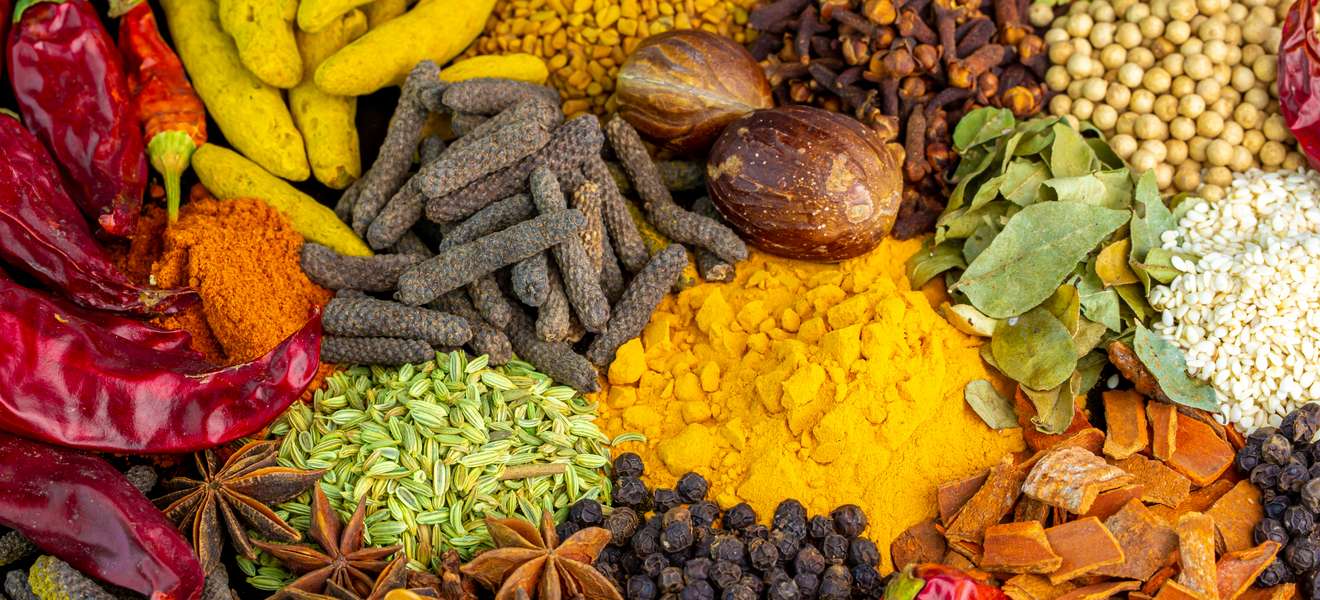History of Indian Spices: Cause of invasion
The history of India is extremely old and extraordinary which is intimately tied to its geography. Ancient India was much more extended to the North-West and West, consisting of parts of Pakistan and Afghanistan. India was the biggest producer of many exotic spices for ages and its flavor was known to the World. Spices and Herbs such as black pepper, cinnamon, turmeric, and cardamom were used in India for thousands of years for both culinary and medicinal purposes. The history of Indian Spices and their dominance in India is evidenced by the many manuscripts and writings available since ancient days.
Sushruta, an ancient surgeon (around 4th century BC) known as the “Father of Surgery“, used white mustard and other aromatic plants in bed sheets to ward off malignant spirits. He used sesame as a poultice for postoperative wounds as an antiseptic. Medical writings of Charaka and Sushruta referenced spices and herbs. The Spices and Herbs such as cinnamon, cardamom, ginger, turmeric, and pepper were used for healing purposes and the Spices such as cardamom, ginger, black pepper, cumin, and mustard seed were included in ancient herbal medicines for different types of health benefits. In Ayurveda, spices are one of the major sources of ingredients for the preparation of medicines.
Who invaded first to India?
For ages, this country has seen many invaders, but its natural isolation and magnetic religions allowed it to adapt and absorb many of those peoples who penetrated its mountain passes. The Aryans first invaded India. They came out of the north in about 1500 BC. The Aryans had very strong cultural traditions that miraculously, deep-rooted in the core of this country and remain in force today. The first documentation of the Vedas was written in Sanskrit, the language of Aryans.
Though warriors and conquerors, the Aryans lived alongside Indus, establishing the basis of the Indian religions. They inhabited the northern regions for about 700 years, then moved further south and east. They eventually settled in the Ganges valley and built large kingdoms throughout much of northern India. Then Persians and Greeks invaded the country. While they subdued the Indus Valley and the northwest, Aryan-based kingdoms continued developing in the East.
The Buddhism religion was founded by the Great king, Siddhartha Gautama in the 5th century BC, was an Aryan. No matter how many Persians, Greeks, Chinese nomads, Arabs, Portuguese, British and other raiders had their way with the land, local Hindu kingdoms invariably survived their depredations, living out their sagas of conquest and collapse. All the while, these local dynasties built upon the roots of a culture well established since the time of the first invaders, the Aryans. In short, India has always been simply too big, too complicated, and too culturally subtle to let anyone’s empire dominate it for a long.
History of Indian Spices: why was India invaded so many times?

India was a land of prosperity, peace, and wealth. It was called “Golden Bird”, because of its cultural richness, best quality textiles, loads of minerals, precious stones, gold and silver, fertile land, rich crops, flora and fauna, and top of that many Herbs and Spices. Indian spices were very famous in the world for their wide range and unique aromas. Spices from India were in great demand in Europe.
Europeans had developed a definite liking for them. Part of the attraction was the flavor they gave dishes, although the long-held view they were primarily used to disguise the taste of bad meat was probably incorrect. Another attraction was their very rarity, making them a fashionable addition to any table and a real status symbol for the wealthy. The spices used in food preparation across Europe included pepper, ginger, cloves, nutmeg, mace, cinnamon, saffron, anise, zedoary, cumin, and cloves.
Although most of these were reserved for the rich, even the poorer classes used pepper whenever they could get it. Despite the cost, Spices were used in great quantities by the Europeans. Royal banquets and weddings without the Sacks of spices were impossible. Spices from China, Indonesia, India, and Sri Lanka (then Ceylon) were originally transported by land from one place to another by donkeys and camels in a caravan. For almost 5000 years the Arabs controlled the spice trade until the Europeans discovered a sea route to India.
Arab merchants who took the spices and other prized goods from the shores of India use to sell to the Venetians who, in turn, sold those spices and goods to the rest of Europe at a much higher price. The trade through the land route was also found very expensive and the capture of Constantinople by the Ottomans in 1453 reduced the trade between Venice and Genoa significantly.
Who first discovered the Sea Route to India?
The European countries were desperate to trade directly with India, direct trade with India would mean better access to the spices and other pricy goods of the land at much better prices. It would also give the country a monopoly over the lucrative spice trade. On 20th May 1498 Vasco Da Gama, the first European arrived in India via sea route mainly for Spices. Thus, the credit for discovering the sea route between these continents is given to Vasco da Gama. Da Gama established a deal with the Zamorin, the king of Calicut for spices and returned with a huge cargo of nutmeg, cloves, cinnamon, ginger, peppercorns, and others in August 1498. He arrived in Malindi in January 1499 and was given a welcome like a hero and the title ‘Dom’ by the king. In this expedition whatever spices and goods, he carried were valued 60 times more than his entire cost of the expedition.

Therefore, ancient India became the preferred destination for many emperors and traders of the world mainly for its natural diversity, rich and diversified culture, and abundant resources of spices and goods. The invaders, therefore, wanted to control this land, the Golden Bird for their utter greediness for wealth. After that history took its course, and gradually the wealth of this country was plundered. Once the richest nation in the world is now labeled as a developing country. India’s share of income from world trade collapsed from 22.6% in 1700, almost equal to Europe’s share at that time, to as low as 3.8% in 1952.
Thus, Spices since the olden days played a major role in the economy of India. Since time immemorial India has been considered the “Spice Bowl of the World”. The history of Indian spices is almost as old as the ‘human civilization ‘. The earliest written record in India on Spices is found in the Vedas – such as the Rig Veda (around 6000 BC) and the others – Yajur Veda, Saam Veda, and the Atharva Veda. During the Vedic period information was primarily handed down orally from generation to generation through the medium of hymns. The Rig Veda contains references to various spices. There is a reference to Black Pepper in the Yajur Veda too.
The well-diversified climatic condition and topography of the country help to grow many varieties. Indian spices grow in every climate and geographical location. The mountains, tropical rainforests, wetlands, marshy woodlands, rich valleys, and green fields, all are rich in spices and herbs. Even in the ancient and medieval ages, Indian spices played a significant role in strengthening its economic condition. The history of Spices in India narrates a long tale of trading with ancient civilizations. Due to the lack of Refrigeration and cold storage, spices were in demand to preserve the flavor of food.
Fierce competition among the European giants initially started to control the spice trade, which led to the colonization of India. The Portuguese, the Dutch, the French, the Spanish, and the British, all established monopolies over certain parts of the spice trade. Empires were built, and fortunes were made by brutal conquests and piracy, all because of hunger and greed. This era saw the formation of the Trading Empire which was known as The British East India Company. What followed is known to every Indian either through life experience or through our history books.
Indian History is, therefore, a bit Spicy, rather we can say that for Spices this country has seen many invaders, wars, and faced slavery.
India’s present position in Spice Bowl Mix
With time, the trade grew in leaps and bounds, and eventually, the Spices Board of India was set up to administer the spice trading. Kerala, Andhra Pradesh, Telengana, Karnataka, Punjab, Gujarat, a few North East states, Uttar Pradesh, and a few more states became the hubs for growing spices. Indian spices are now widely used for flavoring food, medicines, pharmaceuticals, perfumes, and cosmetics. Today, Indian spices are the most sought-after globally, given their exquisite aroma, texture, taste, and medicinal value.
Apart from International, India also has a huge market for spices in Domestic. Traditionally, spices in India have been grown in small land holdings, with organic farming gaining prominence in recent times. India still maintains its dominance in the world market for Spices. It is the world’s largest producer, consumer, and exporter of many spices; the country produces about 75 of the 109 varieties listed by the International Organization for Standardization (ISO) and accounts for half of the global trading in spices. The Spices Board of India works towards the development and worldwide promotion of Indian spices. It provides quality control and certification, registers exporters, documents trade information, and provides inputs to the central government on policy matters.
China and the US are the major export markets for Indian spices, while Bangladesh and the UAE are the major importers of the core spices, such as turmeric and ginger. Just these economies together contribute over 50% of India’s export market.
In 2021, whole-dried chili accounted for 75% of the world market. While the product does not have a direct replacement, but still India should think of competing with Spain, Mexico, and the Netherlands, which are the largest exporter of fresh chillis. Speaking about coriander, although coriander exports reached 57 million metric tonnes in 2021, its incremental unit pricing has been affected due to the volatile size of the sowing area and the availability of a cheaper variant from Russia. Ginger exports, too, accounted for 147.6 million metric tonnes in terms of volume driven by the spice’s potential health benefits. However, India must think about increasing the sowing area to compete with China. About 12.6 million metric tonnes of cardamom were exported during 2021, but again challenges are there in repositioning the product.
Similarly in pepper, the countries like Vietnam, Brazil, and Indonesia are giving tough competition to India.
Conclusion
Spices today are not remained restricted for use in curries and recipes. Now it has extended use in different spiced beverages, concoctions, and ready-to-use products that cater to the international palette. The government of India has visioned achieving a target of US$10 billion by FY 2027. But to achieve this, India needs to focus on more diversification, cultivation, enhancement of sowing area, product innovation, and the promotion of Indian spices abroad.
Photo: The Quint, Wikimedia Commons





Thanks for sharing. I read many of your blog posts, cool, your blog is very good.